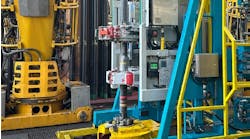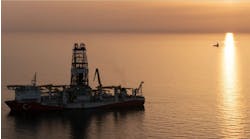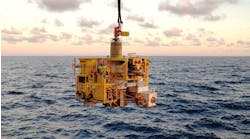Jay Schempf, Special Correspondent
The Deep Offshore Technology (DOT) conference, held annually around the world since 1981, serves as a fountainhead from which oilfield equipment manufacturers and service-providers introduce all-new offshore equipment or services.
Organized by the Offshore Division of PennWell, publisher ofOffshore magazine, the Oil & Gas Journal and other petroleum and non-petroleum industrial publications, along with industry sponsors, DOT focuses on the technical issues involved in all aspects of deepwater exploitation activities. A Board of Advisors made up of key industry executives helps to assure that the DOT technical program continues to meet high standards of professional excellence and technical validity. Additionally, through sharing by key industry leaders of their views and through special panel sessions, DOT provides an overview of the offshore industry’s position vis-à-vis existing challenges and opportunities, thereby setting the basis for more profound discussions.
Technical presentations made at DOT concentrate mainly on deepwater operations in the “Golden Triangle” region of the world - made up of the continental slope areas of the Gulf of Mexico off the US and Mexico, along the broad shoreline sweep of West Africa, and up and down the extreme length of South America’s Atlantic seaboard and in the North Sea.
Until recently DOT was staged alternately in various overseas cities during the odd-numbered years and in the US (New Orleans) during even years. However, in the protracted aftermath of damage by Hurricane Katrina to Louisiana’s deep delta country, including New Orleans, PennWell shifted DOT in 2006 to Houston, Texas, which remains the site for future DOT conferences in the US
Conference plays multiple roles
Time and again, DOT conferences have served to introduce newly cast tool and service innovations for developing crude oil and natural gas resources beneath mainly deep and ultra deepwater. In some cases, technical papers constitute a call by operating companies themselves for new ideas on how to meet specific challenges to drilling, producing, gathering, and transporting deepwater resources. In other instances, equipment manufacturers and service companies, sometimes in tandem with producers, use DOT to debut new, yet practical, tools and techniques that are imminently ready for application in the field.
But John Royall, PennWell’s vice president and group publisher,Offshore, lists still another reason why companies choose DOT to introduce new deepwater equipment and service concepts.
“They sometimes uses DOT to alert competitors to patents or patents pending on the various facets of these new technologies or technical advances,” he says. “For a licensing fee, rivals ultimately can apply them to their deepwater operations.” But other presenters are more interested in acknowledgement of the patents than in the nominal fees involved, he adds.
“While a company has protected intellectual and mechanical property rights to its products or findings, the patent system itself can create opportunities for others to develop similar, but different, technologies, or to expand on the patents themselves,” says Royall. “The offshore industry is known for being the scene for several companies often developing a specific new technology simultaneously, with none being aware of the others’ progress. Ultimately, the entire industry benefits from those kinds of dichotomy.”
Additionally, DOT technical programs include papers that deal with the latest-breaking developments in advancing progress with certain “inevitable” technologies. Novel floating production structures, new mooring materials, dry and wet tree systems, FPSO designs, and other relatively unique technologies often enter the spotlight at DOT conferences, and in successive years are expanded on by companies until subsequent versions are declared unqualified “winners”.
Quality and quantity spell DOT success
While success is often measured by total attendance figures for an industry conference, the number of attendees at DOT has been less important than the qualifications of those attendees to engage in a colloquy about specific aspects of the offshore industry’s quest for deepwater oil and gas. Nevertheless, DOT attendance has risen significantly in recent years, due mainly to a period of growth that promises to provide deepwater opportunities for years to come.
In 1999, for example, the DOT conference held in Stavanger, Norway, drew 865 registrants from 25 countries. During the first five years of the new millennium, as DOT alternated between New Orleans and locations overseas, paid attendance hovered just below 2,000 with registrants from roughly the same number of countries, topping out in 2005 with 1,870 registrants from 26 countries for the conference, held in Vitoria, Brazil.
But in the Houston conference in 2006, DOT organizers were astounded by a total of 3,255 paid registrants, though the number of countries involved remained at 26.
“It was no accident that DOT attendance skyrocketed as much as it did,” says Royall. “The conference agenda has consistently represented an excellent cross-section of the challenges facing the global offshore industry, as well as the innovative solutions to those challenges, as we push the boundaries into deeper and harsher environments.”
Offshore construction company makes good on surprise disclosure
Throughout its 25-year history, the Deep Offshore Technology (DOT) conference has consistently served as a showcase for new equipment and technology - some “game-changing” in nature; others unadorned but nevertheless practical, cost-efficient and effective.
But the source rock at DOT of revelations in new technology isn’t necessarily consigned to the technical program. Sometimes, it comes as real news - and out of the blue.
During the opening session on November 28, the first day of the most recent 2006 conference, for example, John Reed, CEO of the Dutch company Heerema Marine Contractors (HMC), a leading offshore heavy-lift company, noted that there were plans to build a “billion-dollar” crane ship in order to meet some of the larger subsea production and pipeline equipment installations planned or proposed for deepwater locations in the future - as much as three decades hence.
Heerema lost no time in putting the plan into practice. Less than two months after Reed used DOT to announce the company’s intention to build such a ship, it formally declared in early January 2007 that it would build a deepwater construction vessel, to be delivered by 2010, whose cost would be the equivalent of $1 billion - one of a very few, if any, vessels with so lofty a price tag.
Yet unnamed, the vessel - designed in-house - will be 722 ft (220 m) long, 288 ft (88 m) wide, with a draft of 145 ft (44 m). Equipped with a DP3 station-keeping system, it will have dual crane capacity of 15,000 tons (13,608 metric tons) to enable installation of the largest and heaviest of fixed and floating structures so far in existence or planned. Additionally, a new J-Lay tower and deepwater lowering system will allow installation of pipelines of up to 32-in. (813-mm) OD and subsea structures in water depths of 655-11,500 ft (200-3,500 m).
Quarters will accommodate up to 550 persons, upgradeable to 750, the company said. Self-propelled, the vessel will have a maximum speed of 20 knots, which is some four times the speed of any of Heerema’s existing deepwater construction vessels. According to the company, the increased speed will cut travel time between projects dramatically and provide clients with more productivity in a broader geographical range.
Additionally, because of its twin hull design and increased speed, the vessel will add significantly to the feasibility of Arctic offshore construction operations. Crane placement, the J-Lay tower and other installation equipment - as well as the structural quality of the hull and thrusters, are well suited for Arctic environments, the company notes.
The HMC design staff already has begun ordering key components with long lead times, and is discussing options currently with possible suppliers.
The HMC fleet of heavy lift vessels includes three of the world’s largest of their type, theThialf, the Hermod and the Balder. A division of the Heerema Group, HMC is based in Leiden, Netherlands.


